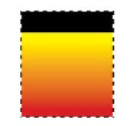The Federal Circuit recently held that trademarks for product packaging consisting of certain colors arranged in a particular design or pattern can be inherently distinctive, regardless of whether the design has any defined peripheral shape or border. In re Forney Indus., Inc., Case No. 19-1073 (Fed. Cir. April 8, 2020) (“Decision”). The Court did not decide whether the mark at issue was inherently distinctive, it remanded for consideration of that question, but the decision does establish for future trademark applicants that the PTO must evaluate marks consisting exclusively of color designs for inherent distinctiveness, and cannot dismiss them out of hand. However, as comparison with Forney’s previous, unsuccessful attempt before the 10th Circuit demonstrates, the claimed mark should be clearly delimited and expressible.
The issue on appeal in Forney concerned the Trademark Trials and Appeals Board (“TTAB”)’s rejection of Forney Industries’ application to register a proposed product packaging mark, replicated at the right. Id. at 2.
Per the applicant’s description of the mark, the dashed border “merely depict[s] placement of the mark” on product packaging, but does not claim any particular shape of that packaging. In re Forney Industries, Inc., 127 U.S.P.Q.2d 1787, Opinion at 8 (TTAB Sept. 10, 2018) (precedential) (“TTAB Opinion”). Although the visual depiction controls over verbal descriptions, the Court described the mark as “the color red fading into yellow in a gradient, with a horizontal black bar at the end of the gradient.” Decision, at 9.
The Federal Circuit found that the Board legally erred in concluding that (1) “a color-based trade dress mark can never be inherently distinctive without differentiating between product design and product packaging marks,” and (2) “product packaging marks that employ color cannot be inherently distinctive in the absence of an association with a well-defined peripheral shape or border.” Id. at 6. The Court found that none of Wal-mart, Qualitex, or Two Pesos supported the plenary prohibitions embodied in the TTAB Opinion. Crucially, the Court found that the TTAB had failed to analyze the claimed mark as a product packaging mark (which, the Board’s decision admitted, can be inherently distinctive), rather than as a product design mark (which cannot).
The Court further held that Forney’s mark was a symbol consisting not just of certain colors, but of colors arranged in a particular design, which can be inherently distinctive, and further found the TTAB’s requirement that a color mark have a defined peripheral shape to have no basis in law. This decision is significant in view of, and consistent with the Tenth Circuit’s opinion in Forney Indus. Inc. v. Daco of Missouri, Inc., 835 F.3d 1238 (10th Cir. 2016), where the Tenth Circuit rejected Forney’s previous attempt to secure trademark protection of its product packaging design. However, in that case, rather than a single, clearly defined design and color pattern, Forney sought to claim a much vaguer and more varied milieu of colors and patterns. See TTAB Opinion at 14, n. 19. Forney’s subsequent narrowing of its claimed mark to a single, clearly delimited pattern and color palette was likely critical to its success before the Federal Circuit.

